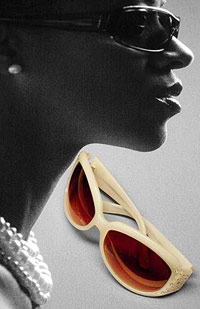The Cool Look In Sunglasses
 Kathryn Wexler - herald.com Kathryn Wexler - herald.com


| | HIGH PROFILE: Model Sheila Powell-Knowles wears Zed, in mineral grey, by Oliver Peoples. The glasses are $260. (Photo: Carl Juste/Herald) |
Last year, there were sporadic sightings of the 1970s - on faces, no less, of the high and mighty hip.

This year, thick, retro sunglass frames transmuted into something more contemporary and widespread.

Next year, predicts Larry Leight, cofounder and chief designer of Oliver Peoples, "the look will be futuristic but still inspired by the '70s."

That's the way with sunglasses, Leight said. Trends run in cycles of three or four years. So if you're under the impression that the shades in stores today look strikingly similar those you saw last year, you're onto something.

And now there's so much more of the same thing to choose from. Every fashion designer worth his Madison Avenue showroom has a line of sunglasses.

This year alone, sunglass lines are being launched by Marc Jacobs, Michael Kors, Louis Vuitton, Emilio Zegna and Perry Ellis. They're joining a market already teeming with runway powerhouses like Alexander McQueen, Giorgio Armani, Calvin Klein, Stella McCartney, Miu Miu, Jil Sander, Vivienne Westwood, Cynthia Rowley and many, many, many more.

Somewhere along the way, looking consummate cool began to require the glossy, impersonal and wholely private sheen of shades.

"It's really almost become like a hip thing to wear sunglasses," said Paula Correri, accessory editor of Tobι Report, a retail analysis publication, "but with aging and plastic surgery, there's a functionality to it as well."

Profits, too, account for the enthusiasm. "It's no longer a first- and second-quarter business; it's becoming a year-round business," Correri said.

Some believe the sunglasses market can't absorb many more designers-come-lately. The Vision Council of America's consumer survey found that in 2004, Americans spent close to$1.9 billion on sunglasses, up from nearly $1.8 billion in 2002.

While the designers may be expert in sunburst pleats or raw silk, their knowledge of gradient lenses and temple hinges is, shall we say, limited. Nor do they have the decades of technological know-how that Italian and, more recently, Japanese sunglass factories do. Consequently, designers almost uniformly use licensees to design and manufacture the lines.

Three companies, Marchon Eyewear, Safilo Group and Luxottica Group, account for the lion's share of designers' contracts. Even the oversized, distinctive sunglasses by Gucci and Chanel, for instance, which seem to have a particular resonance with South Florida consumers, are made by the Italian companies, Safilo and Luxottica respectively.

How well a style reflects its brand's aesthetic depends partly on how much a fashion house gets involved, say industry insiders.

"Some (fashion designers) have eyewear designers on staff who give us designs," said Eden Wexler, spokesperson for Safilo USA. "Some are more knowledgeable than others about what they want."

At the very least, design houses convey a sense of what they're looking for, Wexler said.

"They kind of tell us, `We want something that looks like this,' " she said. "But their idea of great eyewear may not actually be functional."

Sunglasses considered to be of high quality have lenses that block most if not all UV rays. But vendors say that more and more, consumers are inquiring about polarized lenses, which eliminate glare. Other than Prada, few designers offer polarized sunglasses without special orders.

That's because in addition to hiking the cost by about $100, polarized lenses are generally solid and dark and consequently don't lend themselves to more stylized frames, which are more suited for lighter lenses, said Leight of Oliver Peoples.

High-end designer sunglasses generally start at about $220 and can top $400, although some, such as Cartier, cost even more. Sunglasses may be cobbled together with materials from across the world, Leight said.

"You may have lenses from Italy, the bridge from Germany, the metal from Switzerland and frames made in China," he said.

In fact, manufacturers increasingly are tapping China for its cheap labor. Even those stamped "Made in Italy," may have at least one component from Asia, Leight said.

While utilizing Chinese factories lowers the prices for manufacturers, the savings aren't always passed to consumers. "You're still paying for design," he said.

But perhaps China gets a bum rap. Oliver People's newest line, Mosley Tribes, uses frames manufactured in China that sell for $120 to $240 - generally lower than other Oliver Peoples designs. Leight said the quality of the frames are just as high as some of those made in Japan or Italy.

"The Chinese really make them just as good," he said. |



